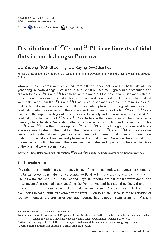摘要
Seven cores were collected from different sediment zones of tidal flats at Xinyanggang in north Jiangsu province in August 2007. Sediment grain-size distribution and radioisotopes of Cs-137 and Pb-210 analysis were carried out for these cores. Sediment rates of the cores and radioisotopes distribution in surface sediment in different zones of the tidal flat were calculated from the Cs-137 and Pb-210 activities in sediments cores. The results indicated that each tidal zone had experienced different evolution phases, hydrological dynamics in the tidal flats made the grain-size of the surface sediment change gradually. Cs-137 and Pb-210 activities on the superficial layer of the cores varied spatially and the reason was discussed. On tidal flats, the fluctuation of Cs-137 and Pb-210 activities in the cores reflected the special sedimentary characteristics. Vegetation affects the grain-size distribution and the vertical profiles of Cs-137 and Pb-210 in the upper depths. Cs-137 and Pb-210 chronology got the comparable average sediment rates on the tidal flat. The characteristics of Cs-137 and Pb-210 in the cores reflected various depositional dynamical environments in different tidal zones and gave information on the different evolvement phases of the tidal zones. Based on the information of grain-size distribution, texture of the cores, sediment rates and topography, the evolution lines of the tidal flat were reconstructed.
- 出版日期2010-2
- 单位南京大学
